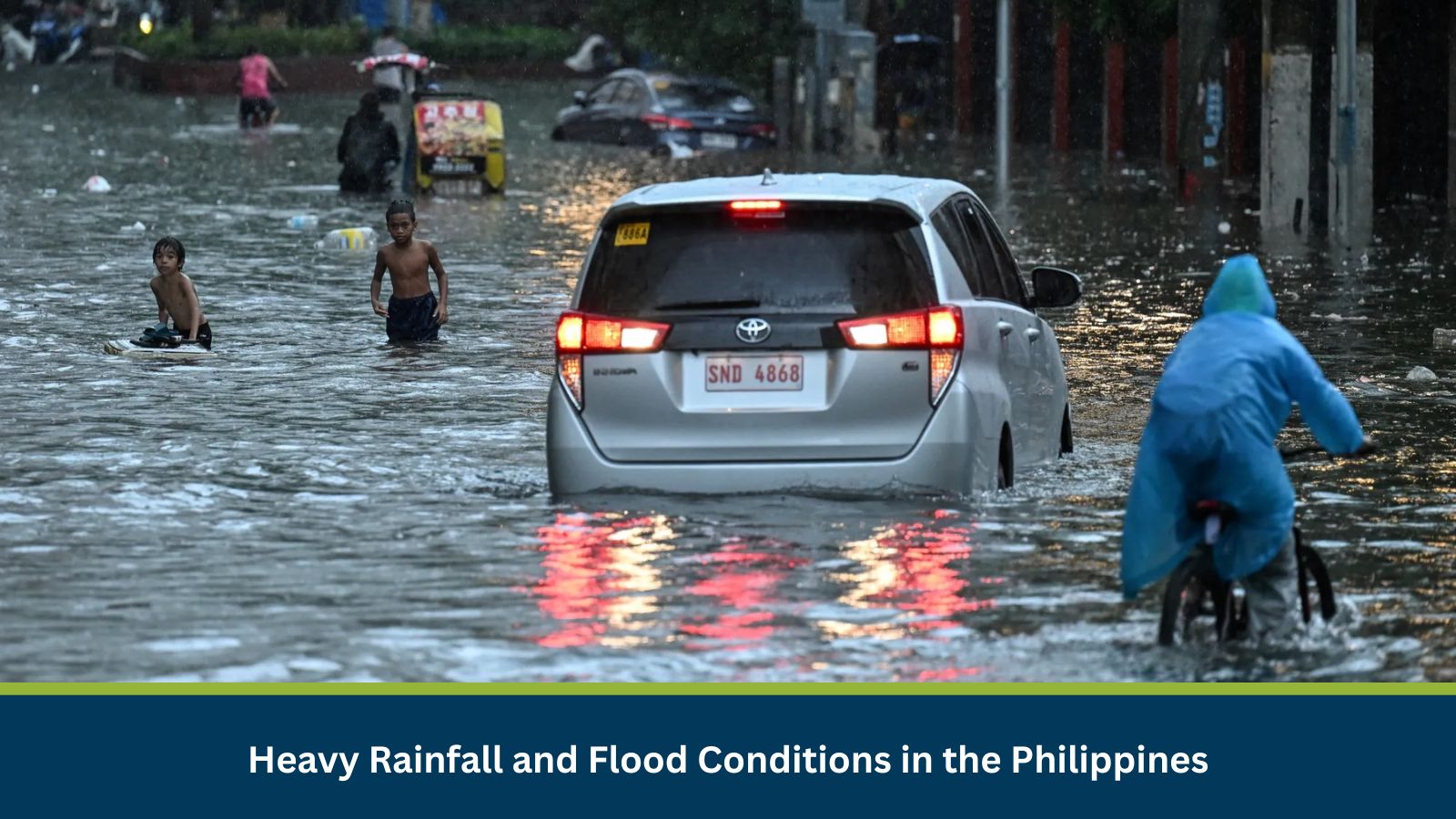This risk assessment evaluates the severe weather advisory for heavy rainfall and flood conditions across parts of the Philippines as of July 22. It aims to provide insights for business continuity, personnel safety, and operational preparedness during the ongoing monsoon-enhanced rainfall event.
What is Risk Analysis in the Context of Environmental Risks?
Environmental risk assessments evaluate how natural phenomena like heavy rainfall and floods impact human safety, critical infrastructure, business operations, and supply chains. They provide timely intelligence that helps organizations prepare for disruptions, mitigate operational risks, and ensure the welfare of staff and assets.
Executive Summary
- Date of Incident: 22 July 2025
- Location: Metro Manila, Quezon City, Iloilo City, Zambales, Bataan, Pampanga, Bulacan, Cavite, Batangas, Rizal, Pangasinan, Tarlac, Laguna, Quezon, Occidental Mindoro, Ilocos Norte, Ilocos Sur, La Union, Oriental Mindoro, Marinduque, Romblon, Masbate, Sorsogon, Albay, Camarines Sur, Catanduanes, Antique, Aklan, Capiz, Iloilo, Negros Occidental, Guimaras, Abra, Benguet, Philippines
- Risk Category: Environment
- Severity Score: 4/5
- Confidence Level: 90%
A severe weather advisory for heavy rainfall and flood conditions across parts of the Philippines indicates a significant and immediate risk as of Tuesday, July 22. The primary impact window is anticipated to extend for the next 3-5 days, with residual flooding and disruption persisting in severely affected low-lying areas for up to 7-10 days. The severity is assessed as moderate to high, justified by the Philippines’ inherent vulnerability to such phenomena, frequently leading to widespread flooding, landslides, and infrastructure damage.
Known Hotspots and Sensitive Areas
High-risk sensitive areas include highly populated informal settlements along riverbanks (e.g., Pasig River, Marikina River, Tullahan River), low-lying coastal communities, and agricultural plains in Central Luzon (e.g., Pampanga, Bulacan). Critical infrastructure such as power substations and major government facilities within flood-prone zones of Quezon City and Manila City are also considered sensitive.
Impact on Transportation and Services
- Road Access: Road closures are anticipated across low-lying sections of Metro Manila, particularly along EDSA-Taft Avenue intersection, Roxas Boulevard (near US Embassy), and parts of C-5 Road due to floodwaters. Provincial roads in Central Luzon, notably segments of the MacArthur Highway in Pampanga and Cagayan Valley Road in Bulacan, are highly susceptible to becoming impassable.
- Public Transport: Significant disruptions to land transport are expected, including suspension of Light Rail Transit (LRT) and Metro Rail Transit (MRT) services during peak flooding, and the cancellation of city buses and jeepneys. Air travel at Ninoy Aquino International Airport (NAIA) may experience delays and cancellations. Sea travel may be suspended in affected coastal areas.
- Utility Services: Widespread power outages are highly probable across affected areas due to submerged distribution lines and damaged transformers. Water supply may be interrupted or contaminated, and communication services (internet, mobile networks) are vulnerable to intermittent disruption.
- Business Operations: Past incidents led to significant operational halts for businesses, affecting workforce availability, customer access, and physical premises due to power outages and accessibility issues.
Recommended Actions
- Activate immediate work-from-home protocols for all non-essential personnel in affected regions.
- Mobilize security and operations teams to elevate critical equipment, secure sensitive documents, and implement flood barriers.
- Engage supply chain and logistics teams to assess real-time road conditions and identify alternative delivery routes and storage facilities.
- Activate crisis communication protocols: HR to maintain real-time contact with employees for welfare checks, while customer service and public relations teams issue proactive advisories to clients.
- Develop and communicate a clear post-flood recovery plan, including protocols for facility damage assessment and safe return-to-work procedures.
Emergency Contacts
- Police: 117 or 911
- Fire Department: 117 or 911
- Ambulance: 117 or 911
- National Emergency: 911
- Official Government Websites:
- Philippine Atmospheric, Geophysical and Astronomical Services Administration (PAGASA): https://www.pagasa.dost.gov.ph/
- National Disaster Risk Reduction and Management Council (NDRRMC): +632 8911-5061 to 65
Final Thoughts
The baseline scenario anticipates localized flooding and temporary road closures, with businesses experiencing minor disruptions. However, persistent heavy rainfall could lead to widespread and prolonged flooding, significantly disrupting regional supply chains and requiring extensive evacuations. In a severe escalation, the rainfall could intensify dramatically, causing catastrophic flooding, major landslides, structural damage to critical infrastructure, and large-scale displacement, leading to significant economic losses and potential humanitarian crisis. Proactive planning and adherence to official advisories are crucial for mitigating risks and ensuring resilience.
Stay ahead of operational risks with real-time alerts, scenario modeling, and expert advisories.
MitKat helps organisations navigate uncertain times by providing comprehensive insights about the evolving risk landscape. We offer various services including Risk consulting and Security Design, Protective Services, and cyber security services which ensure organisations become Risk Intelligent. Our AI-powered operational risk monitoring tool, datasurfr combined with expert insight enables companies to stay abreast of evolving operational risks and emerging developments.






